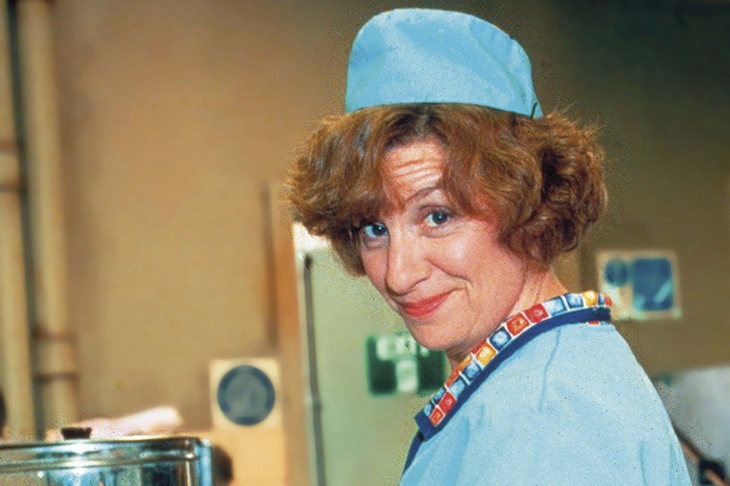Even if you didn’t have an Auntie Dot in Cockermouth (the one who ate a raffia drinks coaster, mistaking it for a high-fibre biscuit), it was impossible not to feel Victoria Wood got you, somehow. Her death in 2016 triggered an outpouring of grief commensurate to her talent, but it also revealed how intimately, how individually, she was loved. Lazily viewed as the cosiest of national treasures, Wood was finer and fiercer than that: she distilled something essential about British character (national, regional, sexual), and her forensic skewering of middle-class aspiration, high and low culture and any and every class of stupidity managed to remain warm: a spectacular balancing act.
Mainly, though, she was wickedly, consistently, funny: Acorn Antiques alone merited a damehood. I could paste 800 words of randomly selected Wood lines here and you would enjoy it more than anything I could write. That is unfortunate for me, but it is a far bigger problem for her biographer Jasper Rees: you can’t possibly be as funny as Wood, so how best to honour her?
With meticulous thoroughness is one answer: Let’s Do It is nearly 600 pages long and copiously footnoted. Rees interviewed Wood frequently in her lifetime, spent two years on research, using Wood’s own audio and written notes, and interviewed more than 200 people (from her children and perennial collaborators to occasional accompanists). It shows — which sounds like a backhanded compliment but isn’t, really: this is an immersive, authoritative book.
Wood describes herself as sounding ‘like a depressed clog’ in an early radio performance
Some of the story is familiar. Wood herself played her isolated Bury childhood and uneasy adolescence for laughs, growing up in her bedroom with ‘a piano, a television and a sandwich’. It seems self-evident she was shyer and less overtly sunny than her public persona. The most cursory assessment of her output (she was the sole creative force for her sketch shows, wrote and starred in Bafta-winning drama and toured tirelessly) makes her obsessive work ethic self-evident. Rees builds on this with a careful accretion of anecdote and detail, creating a picture of someone driven and cagey, yet endlessly delighted by human foolishness (including her own: assessing an early radio performance she describes herself as sounding ‘like a depressed clog’).
There are surprises. Wood’s comedy feels so warm and collegiate it was fascinating to discover her steely insistence on even her closest associates delivering her scripts word and inflection perfect. In her own words: ‘Rehearsals consist of lots of biscuits and me saying “You said nearly instead of almost”.’ Rees describes the cast of Dinnerladies — a riotous hug of a show in which everyone appears to be having a ball — as suffering from ‘post-traumatic sitcom disorder’ trying to meet her exacting standards. Wood was a musician too, after all, and her scripts are music; every bum note was an affront.
It is clear, though, that her creative partnerships were rooted in deep, affectionate affinity. A lovely passage relates the crackle of inspiration that working with Julie Walters ignited: the transformative relief of finding someone Wood trusted absolutely with her words. ‘Integral to this sensation was an instinctive knowledge that she should not hoard the best lines when, in Julie, she had found someone she could be funny with.’
At times the sheer, earnest weight of information has a slightly deadening effect. Details of tour venues, the back and forth of TV commissioning and rehearsal minutiae (‘the first run-through didn’t go well. A major is not a key that clarinets and euphoniums play in’) are really only for the diehard fan preparing for Mastermind. At others, the specificity of these titbits is sublimely Wood. I probably did not need to know about the malfunctioning tailgate on the rented van in which Celia Imrie drove her to Morecambe, or that she and Julie Walters shared ‘liver boil and peas’ in the Goldhawk Road in 1978 before getting ‘stuck in a cul-de-sac’, but I am glad I do.
Some of Rees’s language, too, recalls the precise, bathetic poetry Wood pretty much invented: his description of her honeymoon as ‘a day and a half in Wharfedale’, is straight from the VW playbook. So too are ‘she had a stab at canoeing on Windermere’, or my favourite: ‘The first of Julie’s many hunchbacks.’ I adored Alan Bennett’s contribution (impossible not to hear in his voice): ‘I met Victoria in Sainsbury’s in Lancaster sometime in the Eighties… It was, as she might have chosen herself, in the avocado section.’
Best of all are the gleeful inventories of Wood words and phrases: Rees is a fan, it shows, and that is very winning. ‘Varicose veins, moped, quiche Lorraine, raffia, theodolite, cystitis, grouting, shoplifting, mangling’ is one painstakingly enumerated tally; ‘lentils, punks, the Crossroads motel and macaroons’ reads another.
Did this book need to be so lavishly detailed? Possibly not. But do we really have anything better to do right now than immerse ourselves in granary torpedoes, gussets and guttering? Absolutely not. Do it, I urge you, while the mood is right.






Comments